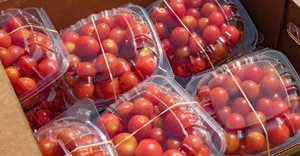Food waste includes uneaten portions of meals, and trimmings from food preparation activities in kitchens, restaurants, fast food chains and cafeterias.
Food waste is the third largest component of generated waste by weight, following yard waste and corrugated boxes. It also is the second largest component of discarded waste by weight after yard waste.
From the early 1960s until 1996, the amount of food waste increased very slowly, according to U.S. Environmental Protection Agency (EPA), Washington, D.C., data.
In 1996, a U.S. Department of Agriculture (USDA), Washington, D.C., Economic Research Service study and two curbside sampling studies showed food waste was generated at a much higher rate than EPA's database originally said was possible.
As a result, EPA changed its food waste generation methodology and increased its food waste estimates for each year in the 1990s. EPA did not revise estimates for any previous years.
Even with the revised data, food waste's share of the solid waste stream has decreased in the past 35 years, largely due to increased consumption of packaged, processed foods.
Food Waste Municipal Solid Waste (MSW) Facts: Generated: * 21.9 million tons or 10.4% by weight.*
* 162.2 pounds of food waste per person.*
Composted: * 520,000 tons for a 2.4% recovery rate.*
* Only three states, Minnesota, New Jersey and Washington, reported recovering more than 10% of generated food waste in 1997.
* 178 food waste composting facilities operated in the United States in 1997.
* Food waste is organic and highly compostable. Grocery store food processing trimmings are a prime resource for composting facilities.
Incinerated or Landfilled: * 21.4 million tons or 14% of discarded MSW by weight.*
Food waste usually is the wettest component of the waste stream with a typical moisture content of 70% and a British thermal unit (Btu) value ranging from 1,500 to 3,000 Btus per pound compared to 4,500 to 5,000 Btus in a pound of MSW.
Landfill Volume: * 21.4 million cubic yards or 5.3 percent of landfilled MSW in 1996.*
Food waste can decompose into methane in a landfill. EPA landfill regulations are designed to limit potential environmental degradation from methane production.
Density: * Landfilled food waste has a density of 2,000 pounds per cubic yard.
* Food scraps, solid and liquid fats have a density of 412 pounds in a 55-gallon drum.
Source Reduction: * Food processing companies that prepare canned or frozen agricultural products for home consumption eliminate much food waste from MSW. In-sink kitchen disposal units transfer disposal of food waste from the solid waste system to the wastewater system.
The Composting Process: Composting is the controlled decomposition of organic matter by microorganisms into a humus-like product. Techniques such as windrows, static piles and in-vessel systems generate energy and heat, and destroy pathogens. Water and carbon dioxide dissipate into the atmosphere during this process. Windrows are the most popular technique of composting food waste.
Temperature control (132 to 140 degrees Fahrenheit), moisture content (40 percent to 60 percent) and an adequate carbon-to-nitrogen ratio are required. An insufficient aeration or improper carbon-to-nitrogen ratio can cause intense odors. Food wastes tend to have a higher nitrogen content than other compostables. Improper operation can allow a fungus, aspergillus fumigatus, to grow on compost piles, causing health problems.
It takes three to 12 months to produce compost, depending on the process and type of food wastes being composted.
Food waste can attract rodents and other vectors. Backyard compost piles that include food wastes must be tightly controlled.
Composting Markets: Food waste compost is not a fertilizer. It is a useful soil conditioner that improves texture, air circulation and drainage. Compost can moderate soil temperature, enhance nutrient and water-holding capacity, decrease erosion, inhibit weed growth and suppress some plant pathogens.
High-quality compost can find a market as a soil amendment and as mulch for farming, horticulture, landscaping and home gardens. Compost also can be used in erosion control and roadside landscaping. Lower-quality compost can be used as a landfill cover or in land reclamation projects.
End-Market Specifications: Each end-market has its own specifications. Generally, non-organic materials (glass, metals, plastic bags, etc.) must be kept separate from food waste.
Composting Cost and Value: Food waste composting facilities usually charge a tipping fee for incoming materials. The average tipping fee in 1997 was $32 per ton. Most of the facilities sold their compost for less than $20 per cubic yard.
For more information on composting, see "From Dirt to Dollars," page 54.
Biocycle, August 1997, April 1999.
Characterization of Municipal Solid Waste in the United States: 1996 Update, 1998. U.S. Environ-mental Protection Agency Office of Solid Waste, Washington, D.C. Website: www.epa.gov/osw
Composting Council of Canada, Toronto. Website: www.compost.org
Cornell Waste Management Institute, Ithaca, N.Y. Website: www.cals.cornell.edu/dept/compost
Handbook of Solid Waste Management, Kreith 1994.
National Recycling Coalition, Alexandria, Va., Measurement Standards and Reporting Guidelines. Website: www.nrc-recycle.org
About the Author(s)
You May Also Like




